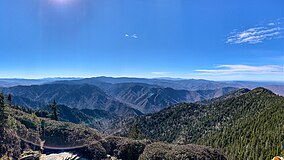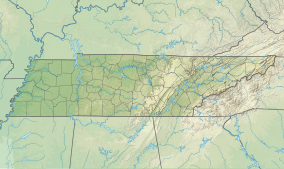
Back حديقة جبال غريت سموكي الوطنية Arabic Parque nacional de los Grandes Montes Fumientos AST Taman Nasional Pagunungan Great Smoky BAN Гранд Смоуки маунтинс (национален парк) Bulgarian Parc Nacional Great Smoky Mountains Catalan Great Smoky Mountains National Park (parke sa Tinipong Bansa, Tennessee) CEB Národní park Great Smoky Mountains Czech Great Smoky Mountains National Park Danish Great-Smoky-Mountains-Nationalpark German Parque nacional de las Grandes Montañas Humeantes Spanish
| Great Smoky Mountains National Park | |
|---|---|
 View from the Cliff Tops formation atop Mount Le Conte | |
| Location | Swain & Haywood counties in North Carolina; Sevier, Blount, & Cocke counties in Tennessee, United States |
| Nearest city | Cherokee, North Carolina, Bryson City, North Carolina, Townsend, Tennessee, Cosby, Tennessee and Gatlinburg, Tennessee |
| Coordinates | 35°36′40″N 83°25′30″W / 35.61111°N 83.42500°W[2] |
| Area | 522,419 acres (2,114.15 km2)[3] |
| Established | June 15, 1934 |
| Visitors | 14,137,812 (in 2020)[4][5] |
| Governing body | National Park Service |
| Website | Great Smoky Mountains National Park |
| Criteria | Natural: vii, viii, ix, x |
| Reference | 259 |
| Inscription | 1983 (7th Session) |
Great Smoky Mountains National Park is an American national park in the southeastern United States, with parts in North Carolina and Tennessee. The park straddles the ridgeline of the Great Smoky Mountains, part of the Blue Ridge Mountains, which are a division of the larger Appalachian Mountain chain. The park contains some of the highest mountains in eastern North America, including Clingmans Dome, Mount Guyot, and Mount Le Conte. The border between the two states runs northeast to southwest through the center of the park. The Appalachian Trail passes through the center of the park on its route from Georgia to Maine. With 13 million visitors in 2023, the Great Smoky Mountains National Park is the most visited national park in the United States.[6]
The park encompasses 522,419 acres (816.28 sq mi; 211,415.47 ha; 2,114.15 km2), making it one of the largest protected areas in the eastern United States.[3] The main park entrances are located along U.S. Highway 441 (Newfound Gap Road) in Gatlinburg, Tennessee, and Cherokee, North Carolina, and also in Townsend, Tennessee. The park is internationally recognized for its mountains, waterfalls, biodiversity, and forests.[7] In addition, the park preserves multiple historical structures that were part of communities occupied by early European-American settlers of the area.[8]
The park was chartered by the United States Congress in 1934 and officially dedicated by President Franklin D. Roosevelt in 1940. The Great Smoky Mountains was the first national park having land and other costs paid in part with federal funds; previous parks were funded wholly with state money or private funds.[9] The park was designated as a UNESCO World Heritage Site in 1983 and an International Biosphere Reserve in 1988.[10]
The park anchors a large tourism industry based in Sevier County, Tennessee, adjacent to the park. Major attractions include Dollywood, the second-most visited tourist attraction in Tennessee, Ober Gatlinburg, and Ripley's Aquarium of the Smokies. Tourism to the park contributes an estimated $2.5 billion annually into the local economy.[11]
- ^ Great Smoky Mountains in United States of America Archived July 24, 2019, at the Wayback Machine. protectedplanet.net. United Nations Environment World Conservation Monitoring Centre and the IUCN's World Commission on Protected Areas. Retrieved July 25, 2019.
- ^ "Great Smoky Mountains National Park". Geographic Names Information System. United States Geological Survey, United States Department of the Interior.
- ^ a b "Listing of acreage – December 31, 2011" (XLSX). Land Resource Division, National Park Service. Retrieved March 7, 2012. (National Park Service Acreage Reports)
- ^ "Annual Visitation Highlights". nps.gov. National Park Service. Archived from the original on February 9, 2021. Retrieved July 8, 2020.
- ^ Riley, Sarah; Lacey, Derek (January 20, 2022). "Great Smoky Mountains National Park shatters previous annual record by 1.5 million visits". The Knoxville News-Sentinel. Archived from the original on March 31, 2022. Retrieved January 22, 2022.
- ^ "Top 10 most visited national parks". Travel. March 27, 2024. Retrieved March 27, 2024.
- ^ "Great Smoky Mountains National Park". Great Smoky Mountains National Park. National Park Service. Archived from the original on July 20, 2006. Retrieved May 3, 2020.
- ^ Cuthbert, Lori; Yogerst, Joe (March 28, 2019). "Everything to know about Great Smoky Mountains National Park". National Geographic. Archived from the original on April 21, 2020. Retrieved May 3, 2020.
- ^ The National Parks: America's Best Idea. Archived from the original on January 1, 2012. Retrieved August 29, 2017. Ken Burns, broadcast on PBS.
- ^ "Global Context". Great Smoky Mountains National Park. National Park Service. Archived from the original on August 1, 2020. Retrieved May 3, 2020.
- ^ "Sevier County's billion-dollar tourist industry grinds to a halt amid COVID-19 pandemic". WVLT-TV. Knoxville, Tennessee. March 23, 2020. Archived from the original on May 16, 2020. Retrieved May 3, 2020.
© MMXXIII Rich X Search. We shall prevail. All rights reserved. Rich X Search

